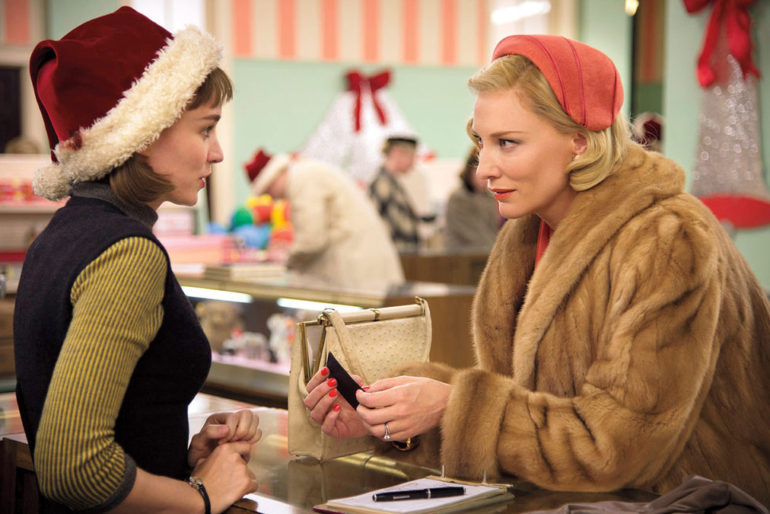One of the most memorable shots in Todd Haynes’ Carol comes early on, when a woman leaves a pair of chocolate brown leather gloves on a shop counter. It’s a simple shot but, like so many others in the film, it exudes tenderness and elegance. The brown contrasts with the glass in the counter and the sickly lime green on the wall in the rear of the shot. The gloves are laid down and patted in a simple motion by the long, eminently ladylike fingers of Cate Blanchett. Carol is a film that deals in high emotion, but it’s the quiet moments, the gazes and pauses, that linger.”
With its 1950s setting and raised emotional stakes, Carol could easily have turned out far more melodramatic than it actually is. That it hasn’t shows that Haynes has moved on the OTT Sirkian stylistics of Far From Heaven. There’s also a maturation in storytelling here; Carol is longer than Far From Heaven, but it feels more streamlined and more confident (Haynes’ TV adaptation of Mildred Pierce must have proved an effective palette cleanser). Though inherently glamorous, the characters in Carol are less constrained by the colours and period trappings. They’re already trapped in more profound ways. Perhaps the greatest achievement of Carol is its relative normalisation of a lesbian love story. Patricia Highsmith’s 1952 source novel The Price of Salt was heralded for its eschewing of stereotypes. Blanchett’s Carol Aird is as refined as any other privileged socialite, with husband (Kyle Chandler’s Harge) and young daughter as markers of a happy life. Likewise, young shopgirl Therese Belivet (Rooney Mara) is demure, and vaguely gamine. Nothing on the surface suggests a mutual attraction like the first glance they share across the shop floor. If love at first sight exists, it looks like this.
As star-crossed as Therese and Carol may seem, Carol is not interested in being a fantastical romance. The opinions of homosexual relationships of the 1950s setting would forbid it, but it also stems from Haynes’ more grounded approach to this material. It helps that Phyllis Nagy’s screenplay seems to take its cue from a line Carol writes to Therese in a letter: “There are no accidents” (A sentiment that doubtlessly appealed to trained semiotician Haynes). Carol leaves her gloves in the store, and Therese has her address to which to ship an order. She performs a common courtesy by sending on Carol’s gloves, but were they left on purpose? What does it matter? What matters is that these two want to see each other again (“Perhaps you’d like to come visit me”, Carol offers faux-innocently. Therese can only answer with a breathy ‘Yes’). The personal dilemmas of these characters are sold by two magnificent actresses. Mara took deservedly took acting honours at Cannes for her turn as Therese; her doe-eyed look hides knowing street-smarts and sensuality. It’s an appealing combination for a suitor, as evidenced by Carol as well as her own boyfriend Richard (Jake Lacy): Therese looks to be in need of rescuing, but she can hold her own, and Mara does a fine job of of meshing these elements together. Meanwhile, Blanchett delivers her best performance in a career full of bests, performing a similar concealment to Mara’s. Despite those elongated elegant looks, her earthy voice quivers (sometimes in desire, sometimes in pain) to expose a surprising brittleness, reminiscent of Jasmine’s blues. The two together are a powderkeg; when fate turns against them, the emotions are explosive. Chandler and Sarah Paulson offer fine support in potentially one-note roles (husband and best friend respectively), but Nagy and Haynes put the personal travails of our central couple first and foremost. Like them, Carol is warring against the labels and limits of the setting, and it’s winning.
There’s scarcely a foot put wrong in the background. The recreation of the early 1950s is pitch perfect, but two names in particular warrant mention. Sandy Powell’s costume design is a masterful example of character being woven into clothes; contrast Therese’s jejune beret with Carol’s grande dame furs. The fabrics can almost be held in Ed Lachman’s lighting and camerawork. His super-16 work here is a world away from Sirkian pastels. This world feels lived in, like Don Draper might walk past in the background as an extra. The dimly-lit greens and browns offer a warming contrast to the chilly Christmas setting. Indeed, the passing of Christmas and New Year’s blends into the background as Carol and Therese take the first tentative steps towards figuring out what their relationship is to become. Pleasantly, though we’ve seen similar stories unfold before, Haynes ensures that Carol is infused with a sense of hope. We want this pair to be together; they are inextricably linked. We believe in Therese and Carol, and thus we believe in Carol. May all their Christmas wishes come true.
Carol is due for release in Irish cinemas on 27th November.

